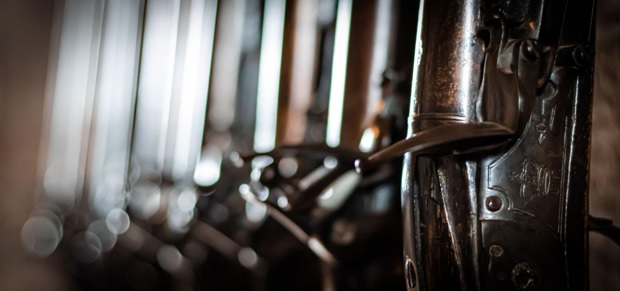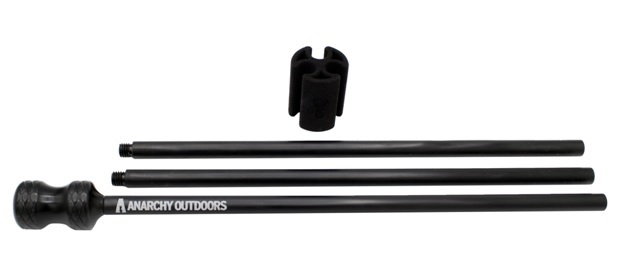The Problem with Wooden and Fiberglass Muzzleloader Ramrods
Aug 10th 2024
You ever hear the expression, “ramrod straight”? It’s a reference to something being very straight, either physically, or more frequently, in nature - which connotes an unyielding, obstinate character.
It is a reference to the actual ramrod, which is among the most vital of all muzzleloader accessories. The ramrod is necessary not only for loading a muzzleloader, but also for clearing the bore of obstructions after shooting, as well as for cleaning and other maintenance.
There is probably no other more central muzzleloader accessory. A muzzleloader without a ramrod is like a canoe without a paddle - which brings to mind another aphorism, that about being up a creek, and so on and so forth.
It is ironic, then, that for so long manufacturers have made muzzleloader ramrods out of wood, and only relatively recently started utilizing fiberglass, when both of these materials showcase glaring shortcomings. These we will unpack here.
Originally, wood was used as a material simply because there was no practical alternative. In the early days (and in the heyday) of muzzleloading, shut-pan shooters used wood ramrods because that’s all they had. Sure, you could make one from a bar of iron, but iron is heavy and would scratch the bore. Wood was better.
The issues, however, were many. Despite the lightweight nature and relative strength and flexibility of a wooden ramrod, it is comically easy to break one. Try forcing home a ball or bullet by grasping the ramrod more than six inches above the muzzle and you’ll soon have two ramrods.
Breaking one off is a disaster in the field because it means you now have a crippled muzzleloader that can’t be fired till the ball is pulled - which you also can’t do with a broken ramrod. It can end a hunt, or worse.
Nowadays, the manufacturers that still make wooden ramrods likely do so for purposes of nostalgia. Beyond that, it’s a true conundrum why anyone would use a wooden ramrod, besides for the value of authenticity.
And so, enterprising manufacturers plied the waters of innovation by designing and producing fiberglass ramrods. Like wood, these were very light, but unlike wood, they could be manufactured to be stronger and more flexible.
Granted, fiberglass is theoretically an improvement over wooden ramrods, but the cold hard truth is that fiberglass ramrods can and still do break, and when they do, the issues are the same. An ended day at the range, or worse, a failed hunt.
These issues are self evident, and are the main reasons why more enterprising manufacturers have decided to end the problem by designing a solution which categorically lacks the failures of these predecessors - despite the fact that is utterly devoid of the traditional heir of its forebears.

The Solution Is Neither
Enter aluminum ramrods. This material solves pretty much all of the problems faced by both wooden and fiberglass ramrods, as well as some others that might be presented by other materials.
Aluminum is extremely lightweight, lighter in weight than many species of woods, and generally comparable to fiberglass. However, it exceeds both in strength. Though aluminum is not as flexible as either, it compromises by offering far superior strength; it would be difficult to bend one anyway, and if it does bend, it will set rather than break. Following good practices, not grabbing the ramrod too high over the muzzle, will help prevent this, anyway.
The fact that it won’t break is enough benefit to warrant its use in making muzzleloader ramrods. If you’re forceful with it it will bend but not break. Either way, if that happens, you’re doing something wrong.
Another benefit of aluminum is that it’s pretty much too soft to scratch the bore of a muzzleloader. Not that wood and fiberglass present that issue, but it is something to be considered.
Now, admittedly, single piece aluminum ramrods are good enough, and, in their own right, represent a substantial upgrade over both fiberglass and traditional wooden muzzleloader ramrods.
But, like these predecessors, they are large, cumbersome, unwieldy, and difficult to carry except under the barrel of your muzzleloader. If they don’t fit there, forget it.
That’s why 3-piece aluminum muzzleloader ramrods are better.
Why a Multi-Piece Ramrod?

It might seem counterintuitive to make a ramrod from multiple pieces since breaking and bending are chief concerns with ramrods. On top of that, a threaded design is ostensibly weak, since threads are fragile.
Not in the case of this muzzleloader ramrod, which is made with deep, coarse threads, which are exceptionally strong and which allow for easy, quick, intuitive assembly, when fast reloads are necessary.
This three piece muzzleloader ramrod is made with lightweight yet exceptionally strong aircraft grade aluminum that is highly corrosion resistant. As a result, it boasts all of the other potential benefits of aluminum, and unlike wood and fiberglass will not crack or break.
On top of that, the ability to break down this ramrod means it can easily be stashed in a hunting pack or possibles bag - unlike other muzzleloader ramrods. This gives it a significant advantage over one-piece ramrods, especially if you’ve had problems finding an alternative that fits in your ramrod slot. This one, since it is modular, is more versatile.
One more thing: it’s made in the United States, so you can buy comfortably knowing you’re buying American.
Explore Muzzleloader Ramrods and Other Muzzleloader Accessories Here
Interested in learning more about some of the other relative virtues of this three piece aluminum muzzleloader ramrod, which represents a groundbreaking upgrade over wooden and fiberglass ramrods, and even over single piece aluminum ramrods?
You can learn more about this revolutionary muzzleloader ramrod here. While you’re here, make sure you check out our full collection of muzzleloader accessories, which includes primer holders, muzzleloader speed loaders, bullet and ball starters, bullets, funnels, sights, jags and bolt knobs, loading blocks, muzzleloader stocks, and much more. We even carry muzzleloader muzzle brakes. For more information see the previous collection or get in touch with us directly at 833-980-0333.









